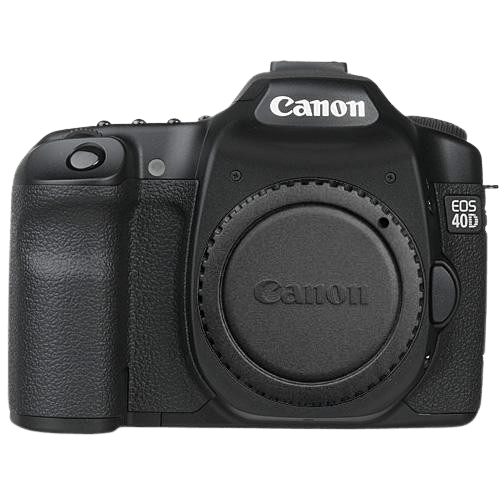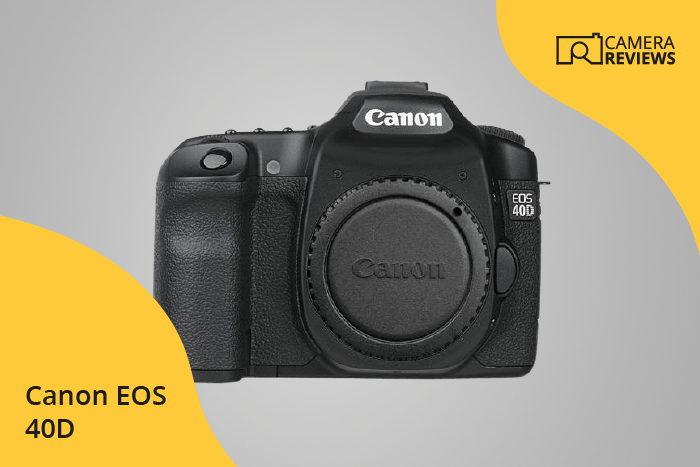Canon EOS 40D Specs and Scores

The Canon EOS 40D, a DSLR camera, has a score of 42/100. Announced on August 20, 2007, and released the same year, it was initially priced at $899. The camera’s dimensions are 146 x 108 x 74mm, and it weighs 822g (1.81lbs).
Looking at these specifications, the EOS 40D is not the most competitive model in today’s market. Its score and launch date reflect its age and limitations compared to more modern cameras. Despite this, the EOS 40D still has its merits, and users may find its features suitable for their needs.
Canon EOS 40D Overview and Optics
The Canon EOS 40D receives an optics score of 45/100. It features 10.1 megapixels, a shooting speed of 6.5 frames per second, and a CMOS sensor with a DXOMARK score of 64. The camera has a Digic III processor, an APS-C sensor size, and a Canon EF-S lens mount. However, it lacks image stabilization and has an aspect ratio of 3:2.
Comparing these specifications to current market standards, the 40D falls behind in terms of megapixels and sensor performance. Modern cameras typically offer higher megapixel counts and better sensor scores, resulting in improved image quality. Additionally, the absence of image stabilization in the 40D may lead to compromised image sharpness, especially in low-light conditions or during handheld shooting.
Despite its dated specifications, the Canon EOS 40D still provides decent image quality for casual photography. However, for those seeking top-notch performance and features, newer models in the market are more suitable.
Canon EOS 40D Video Performance
While discussing the Canon EOS 40D’s features, it is important to note that this camera lacks video capabilities. Unlike many modern cameras, the EOS 40D cannot record video, focusing solely on photography.
Canon EOS 40D Features and Benefits
The Canon EOS 40D’s features score stands at 36/100. The camera has a 3-inch screen with a resolution of 230,000 dots, which is significantly lower compared to modern cameras. The lack of touchscreen functionality and a flip screen limits the user’s flexibility and ease of use. Additionally, the camera does not offer GPS, Wi-Fi, or Bluetooth connectivity options, which have become standard features in today’s market.
When compared to current camera models, the Canon EOS 40D’s specifications fall short in terms of technology and user experience. Despite its solid performance in other areas, the camera’s outdated features make it less competitive in the modern market. Those seeking a camera with advanced features and connectivity options should consider newer models in the Canon line or explore other brands.
Canon EOS 40D Storage and Battery
The storage and battery score for the Canon EOS 40D is 35 out of 100. This camera has one memory card slot, accepting only Compact Flash (Type I or II) cards. Compared to modern cameras, which often support multiple memory card formats and have multiple slots, the EOS 40D lags behind in terms of storage options.
The battery life of the EOS 40D is 800 shots per charge, using a BP-511 battery type. This amount is respectable, but not outstanding when compared to newer models. Additionally, the camera lacks USB charging, which is now a common feature in today’s market.
The Canon EOS 40D’s storage and battery specifications show its age, as it falls short in comparison to current camera options. While it may still be useful for some users, its limitations should be considered when assessing its overall performance.
Canon EOS 40D Alternatives
Do you want to know how the Canon EOS 40D compares to its competitors? Have a look at the most popular comparisons for this camera below:
- Canon EOS 40D vs EOS 50D
- Canon EOS 40D vs EOS 5D Mark III
- Canon EOS 40D vs EOS M50 Mark II
- Canon EOS 40D vs EOS 30D
- Canon EOS 40D vs EOS 5D
- Canon EOS 40D vs EOS Rebel T100 / 4000D
Canon EOS 40D FAQ
Does the Canon EOS 40D Have Built-in Image Stabilization?
The Canon EOS 40D does not have built-in image stabilization. However, it can utilize lenses with optical image stabilization to reduce camera shake and produce sharper images.
Does the Canon EOS 40D Support 4K Video Recording?
The Canon EOS 40D does not support 4K video recording as it does not have video functionality at all. It is primarily a still photography camera.
What Size Sensor Does The Canon EOS 40D Have?
The Canon EOS 40D features an APS-C sized sensor, which is smaller than a full-frame sensor but larger than a Micro Four Thirds sensor, providing good image quality and performance.
Does the Canon EOS 40D Have a Dual Memory Card Slot?
The Canon EOS 40D does not have a dual memory card slot. It only has a single slot that supports CompactFlash memory cards.
Does the Canon EOS 40D Have a Touch Screen?
No, the Canon EOS 40D does not have a touch screen. It features a 3-inch LCD screen for image preview and menu navigation, but it is not touch-sensitive.
Does the Canon EOS 40D Have Wi-Fi and Bluetooth?
The Canon EOS 40D does not have built-in Wi-Fi or Bluetooth connectivity. To transfer images wirelessly, you will need to use an external Wi-Fi adapter or card reader.
Does the Canon EOS 40D Have GPS?
The Canon EOS 40D does not have built-in GPS functionality. You can, however, add GPS data to your images using an external GPS device connected to the camera.
Is the Canon EOS 40D Weather Sealed?
The Canon EOS 40D is not fully weather-sealed, but it does have some dust and moisture resistance. It is advisable to use a protective cover in harsh weather conditions.
Does the Canon EOS 40D Have a Built-in Flash?
Yes, the Canon EOS 40D has a built-in pop-up flash that can be used for fill light or as a master flash for controlling external Speedlite flashes wirelessly.

